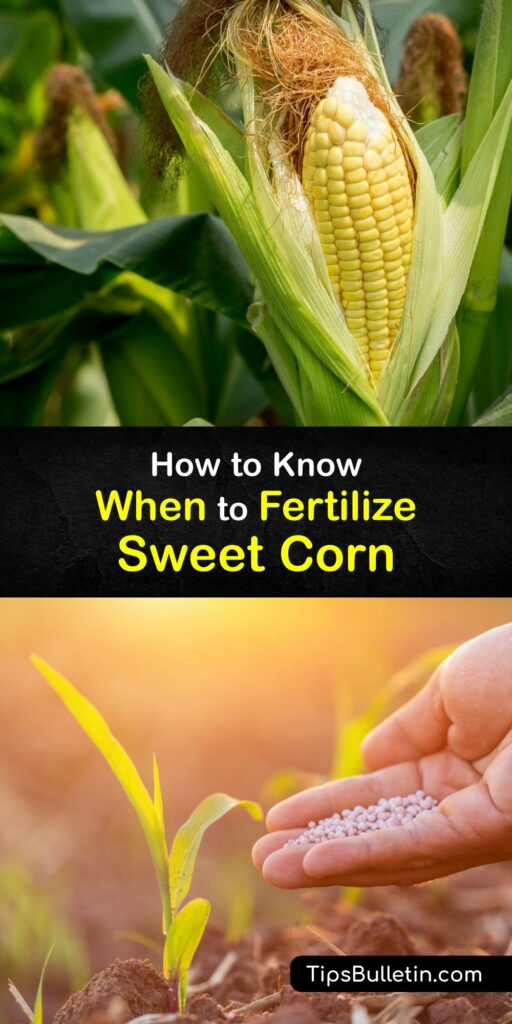Growing sweet corn in the backyard garden is an excellent way to enjoy fresh corn at the end of the growing season. Yet, not providing your corn crop with proper nutrients results in a poor yield. Learn how and when to fertilize sweet corn and what your corn plants need to thrive and produce sweet cobs of corn.
Sowing sweet corn seed is the easiest part of growing corn, but there is more to planting corn than burying the seed in the ground and giving it the occasional drink of water. Corn seed requires the right soil temperature to germinate, and a corn plant needs full sun, loamy, fertile, and well-draining soil to grow.
Fortunately, there are ways to provide your corn patch with everything it wants, even if you have sandy soil. Corn needs to be planted when the soil is balanced with minerals. The first step is to perform a soil test and the results help you determine what your garden lacks, making the job of enriching the soil easier.

Fertilizing Sweet Corn Plants
It’s important to fertilize sweet corn before and during the growing process. The best fertilizer for sweet corn depends on your garden’s soil type. Some areas have clay soil, others are sandy, and then there are those that are rich and perfect for corn production.
Learn which nutrients corn plants need before and after planting your favorite sweet corn variety. Discover when and how to feed your plants and how to make a DIY fertilizer for the crop. Ensure you get a bountiful harvest of sweet and delicious ears of corn at harvest time.

Best Fertilizer for Sweet Corn
Fertilizers offer plants an array of nutrients and minerals, and their ratios vary. Find out how to pick the best fertilizer for sweet corn by understanding the type of nutrition this plant requires for development.
Sweet corn plants want plenty of nitrogen and phosphorus as they mature through the corn growing season. Additionally, they need magnesium, potassium, and other nutrients that most soil types contain. Nitrogen gives the plant energy for leaf growth, phosphorus helps it grow healthy roots, and potassium encourages a strong and fast-growing stem.
It’s vital to understand the nutrient ratio when using commercial fertilizer. The three main ingredients you see on fertilizer products are nitrogen, phosphorus, and potassium, or NPK. Each number represents the amount of each nutrient in the fertilizer – the higher the number, the more concentrated it is.
Plant your corn variety in well-drained soil with organic matter, a soil pH of 5.8 to 7.0, and the necessary minerals. They should flourish and grow tasty ears of corn for harvesting. Encourage beneficial insects for pollination, deter the corn borer, corn earworm, and other harmful pests, and perform crop rotation to prevent corn smut on the kernels.
Natural Fertilizer for Sweet Corn
Your local hardware store or garden center carries granular and chemical fertilizers, but these products are pricey and not always good for the environment. Explore the different types of natural fertilizer for sweet corn to help you choose the proper one for your home garden.
Alfalfa meal has four percent nitrogen. Cottonseed meal, soybean meal, and fish fertilizer have six percent or more. If your soil is low on nitrogen, consider using blood meal or feather meal since these two contain 12 to 14% of this necessary nutrient.
If your plants need a quick nitrogen boost, use blood meal or cottonseed meal instead of feather meal since the latter takes longer to break down in the soil.
When to Fertilize Sweet Corn
When is the best time to fertilize sweet corn? Unlike other plants that are happy with one application of plant food, sweet corn plants want fertilizer at several times during the year to ensure they produce a good yield.
Fertilize before you begin to plant corn to enrich the soil and give the seedlings the nutrition they require to mature. However, if your soil is acidic, consider adding lime to the garden in the fall before planting.
After seeding, when the corn plants are 12 inches tall, side-dress them with an organic fertilizer. Finally, fertilize them when they are eight to ten weeks old.
How to Fertilizer Sweet Corn
While you may be familiar with feeding houseplants, fertilizing sweet corn is different, whether you’re using a commercial or natural fertilizer. Fertilize corn before planting and after your corn plants are growing.
Before planting, spread three to four pounds of 10-10-10 fertilizer for every 100 square feet. Broadcast it evenly and work it into the top three inches of dirt. In about four weeks, begin side dressing by applying eight ounces of high nitrogen fertilizer to every row.
Apply bands of fertilizer approximately three inches from each side of the corn stalk to avoid burning the roots. Feed them a 16-16-8 fertilizer one more time after two months of growth.
Protect your plants from the European corn borer and other corn pests, and prepare to harvest corn at the end of the season. Avoid overfertilizing the corn, or spraying liquid fertilizer on the corn plant’s leaves, especially if it’s a high N fertilizer. Water the corn each time you feed them, and stop fertilizing when the ears begin to show silk.
Unlike field corn, the sweet corn variety is perfectly sweet, with the right amount of juiciness in every kernel. There are many sweet corn variety plants to grow, from standard sweet corn to supersweet corn. It’s vital to feed homegrown corn with nitrogen fertilizer when you plant sweet corn to ensure a healthy crop.

Now that you know how and when to fertilize sweet corn for optimal plant growth, why not share our sweet corn fertilization guide with the corn-lovers in your life on Facebook and Pinterest?